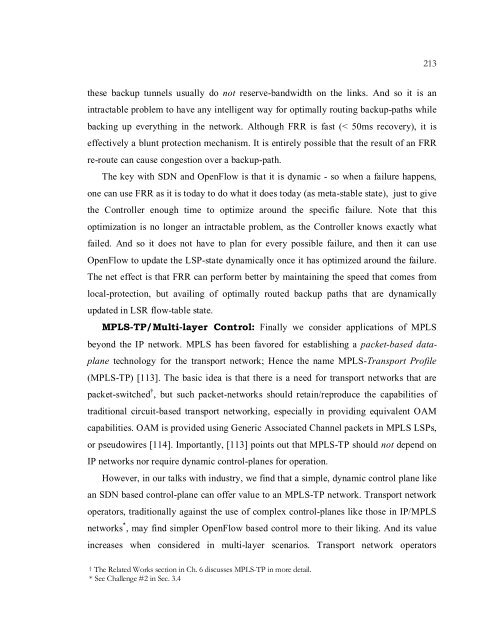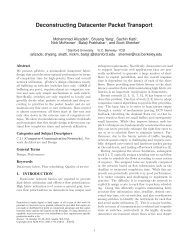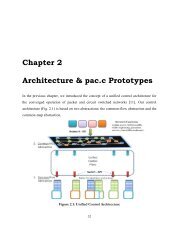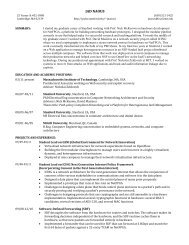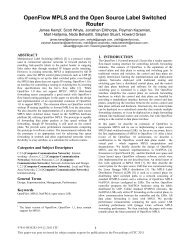Chapter 5 Introducing SDN Control in MPLS Networks - High ...
Chapter 5 Introducing SDN Control in MPLS Networks - High ...
Chapter 5 Introducing SDN Control in MPLS Networks - High ...
Create successful ePaper yourself
Turn your PDF publications into a flip-book with our unique Google optimized e-Paper software.
213these backup tunnels usually do not reserve-bandwidth on the l<strong>in</strong>ks. And so it is an<strong>in</strong>tractable problem to have any <strong>in</strong>telligent way for optimally rout<strong>in</strong>g backup-paths whileback<strong>in</strong>g up everyth<strong>in</strong>g <strong>in</strong> the network. Although FRR is fast (< 50ms recovery), it iseffectively a blunt protection mechanism. It is entirely possible that the result of an FRRre-route can cause congestion over a backup-path.The key with <strong>SDN</strong> and OpenFlow is that it is dynamic - so when a failure happens,one can use FRR as it is today to do what it does today (as meta-stable state), just to givethe <strong>Control</strong>ler enough time to optimize around the specific failure. Note that thisoptimization is no longer an <strong>in</strong>tractable problem, as the <strong>Control</strong>ler knows exactly whatfailed. And so it does not have to plan for every possible failure, and then it can useOpenFlow to update the LSP-state dynamically once it has optimized around the failure.The net effect is that FRR can perform better by ma<strong>in</strong>ta<strong>in</strong><strong>in</strong>g the speed that comes fromlocal-protection, but avail<strong>in</strong>g of optimally routed backup paths that are dynamicallyupdated <strong>in</strong> LSR flow-table state.<strong>MPLS</strong>-TP/Multi-layer <strong>Control</strong>: F<strong>in</strong>ally we consider applications of <strong>MPLS</strong>beyond the IP network. <strong>MPLS</strong> has been favored for establish<strong>in</strong>g a packet-based dataplanetechnology for the transport network; Hence the name <strong>MPLS</strong>-Transport Profile(<strong>MPLS</strong>-TP)[113]. The basic idea is that there is a need for transport networks that arepacket-switched † , but such packet-networks should reta<strong>in</strong>/reproduce the capabilities oftraditional circuit-based transport network<strong>in</strong>g, especially <strong>in</strong> provid<strong>in</strong>g equivalent OAMcapabilities. OAM is provided us<strong>in</strong>g Generic Associated Channel packets <strong>in</strong> <strong>MPLS</strong> LSPs,or pseudowires [114]. Importantly, [113] po<strong>in</strong>ts out that <strong>MPLS</strong>-TP should not depend onIP networks nor require dynamic control-planes for operation.However, <strong>in</strong> our talks with <strong>in</strong>dustry, we f<strong>in</strong>d that a simple, dynamic control plane likean <strong>SDN</strong> based control-plane can offer value to an <strong>MPLS</strong>-TP network. Transport networkoperators, traditionally aga<strong>in</strong>st the use of complex control-planes like those <strong>in</strong> IP/<strong>MPLS</strong>networks * , may f<strong>in</strong>d simpler OpenFlow based control more to their lik<strong>in</strong>g. And its value<strong>in</strong>creases when considered <strong>in</strong> multi-layer scenarios. Transport network operators† The Related Works section <strong>in</strong> Ch. 6 discusses <strong>MPLS</strong>-TP <strong>in</strong> more detail.* See Challenge #2 <strong>in</strong> Sec. 3.4


